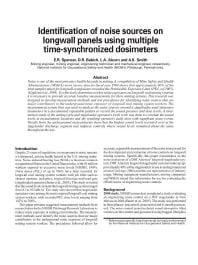Mining Publication: Identification of Noise Sources on Longwall Panels Using Multiple Time-Synchronized Dosimeters
Original creation date: December 2007
Authors: ER Spencer, DR Babich, LA Alcorn, AK Smith
NIOSHTIC2 Number: 20033108
Trans Soc Min Metall Explor 2007 Dec 322:51-56
Noise is one of the most pervasive health hazards in mining. A compilation of Mine Safety and Health Administration (MSHA) noise survey data for Fiscal year 1990 shows that approximately 40% of the total samples taken for longwall occupations exceeded the Permissible Exposure Limit (PEL) of 100%. In order to properly determine workers' exposures on longwall coal mining systems, it is necessary to provide accurate baseline measurements for these mining systems. This research was designed to develop guidelines and test procedures for identifying all noise sources that are major contributors to the underground noise exposure of longwall coal mining system workers. Once the high noise sources are identified, promising engineering controls can be tested and evaluated to reduce the noise of the sources. The measurement system used to analyze the noise sources included stationary dosimeters in a documented repeatable pattern and a time-motion study of the cutting cycle and operator's work cycle. Significant results from the underground measurements show that the highest sound levels recorded are at the stageloader discharge segment and tailpiece controls and remained at about the same level throughout the test.

NIOSHTIC2 Number: 20033108
Trans Soc Min Metall Explor 2007 Dec 322:51-56
- Develop and Evaluate Engineering Noise Controls for Air Carbon Arc Cutting and Gouging
- A Dual Sprocket Chain as a Noise Control for a Continuous Mining Machine
- Engineering Noise Controls for Longwall Mining Systems
- Limestone Mining: Is It Noisy or Not?
- Mining Haul Truck Cab Noise: An Evaluation of Three Acoustical Environments
- The Modern Evolution of Hearing Conservation Regulations
- Modified Tail Section Reduces Noise on a Continuous Mining Machine
- Noise Exposure in Longwall Mining and Engineering Controls Research
- Noise Source Identification on a Continuous Mining Machine
- Summary of Longwall and Continuous Miner Section Noise Studies in Underground Coal Mines